Overwhelmingly, the world is going agile. Companies that adopt Agile methodologies see a range of benefits, from higher rates of customer satisfaction, stronger employee engagement, and primarily smoother operations. Agile teams benefit significantly from these methodologies, resulting in enhanced collaboration and productivity.
Still, despite all the positives related to Agile planning, many businesses haven’t adopted the practice. Whether out of hesitance for change or a desire to keep things status quo, companies who aren’t using an Agile approach, and Agile planning risk falling behind the competition.
In this blog post, we’re going to dive into what the approach is and the steps you can take to apply it to your own workflows, especially for software development projects.
Try monday devWhat is agile planning?
Agile planning is a part of the Agile methodology, which is a project management style with an incremental, iterative approach. Instead of using an in-depth plan from the start of the project—which is typically product-related—Agile leaves room for requirement changes throughout and relies on constant feedback from end users. Agile teams utilize these principles to stay adaptable and responsive.
With Agile planning, a project is broken down into smaller, more manageable tasks with the ultimate goal of having a defined image of a project’s vision. Agile planning involves looking at different aspects of a project’s tasks and how they’ll be achieved, for example:
- Roadmaps to guide a product’s release ad schedule
- Sprints to work on one specific group of tasks at a time
- A feedback plan to allow teams to stay flexible and easily adapt to change
- User stories, or the tasks in a project, capture user requirements from the end user’s perspective
Essentially, with Agile planning, a team would decide on a set of user stories to action at any given time, using them as a guide to implement new features or functionalities in a tool. Looking at tasks as user stories is a helpful way to imagine how a customer may use a feature and helps teams prioritize work and focus on delivering value first.
Essential characteristics of Agile planning
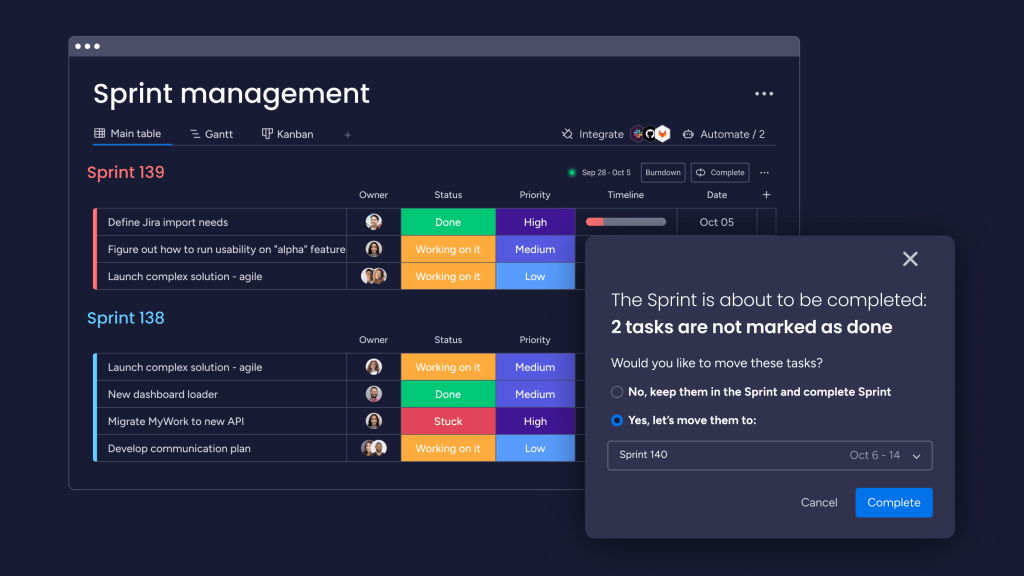
A whopping 71% of organizations have adopted agile planning methodologies, and 60% of those companies increased their profits after doing so. However, implementing Agile methodologies is important and can dictate the success of this new project management format in your company. Before implementing any project planning method, whether it’s Kanban boards, Gantt charts, or Scrum, it’s important to understand the basics. Here are four essential characteristics of Agile you should be aware of.
An agile project plan is divided into releases and sprints
Agile planners define a release as creating a new product or substantially updating an existing product. Each release is broken down into several iterations called sprints. Each sprint has a fixed length, typically two weeks, and the team has a predefined list of items, or user stories, to work through in each sprint.
Task creation and planning is based on user stories
As mentioned above, a user story is a task that caters to an end-user’s needs. For example, when working on a software product, teams may work on features based on user stories, such as:
- “As a team member, it’s helpful for me to receive a notification telling me which new tasks are assigned to me.”
- “As a team leader, I need to receive an email when a task is stuck or behind schedule so I can keep my project on track.”
Unlike other project management methodologies, like waterfall, in which teams would create detailed technical specifications of exactly what they would build, with Agile planning, teams focus on documenting what users need. Throughout the sprint, team members figure out how to address specific user needs in the most efficient way possible.
For a more in-depth comparison, read our Agile vs Waterfall guide.
Planning is iterative and incremental
All sprints are of equal length, and an Agile team repeats the same process over and over again, like Scrum ceremonies, in every sprint. The result of each sprint should be working features that can be rolled out to end-users.
An iterative process allows the team to learn what they are capable of, estimate how many user stories they can action and finish in a given timeframe, and discover problems that impede their progress. Then, newly discovered problems can be addressed in subsequent sprints.
Work estimation is a collective effort
A focal point of Agile planning is that development teams should participate in planning and estimation, instead of solely management deciding on the work scope. In the sprint stage, Agile planning allows teams to determine the complexity of user stories to carry out a plan, called a story point.
For example, a team can assign 1 point to a simple user story, 2-3 points for a moderately complex one, and 4-5 points for a bigger story based on their understanding of the work involved. Then, user stories that aren’t actioned or assigned points on the current sprint are put into the project backlog.
The 6 levels of Agile planning
Agile planning is a multi-level process, with each stage representing a different part of the planning process. Often, people refer to the Agile planning process as an Agile planning onion for its different layers, each one giving way to the next. When looking at Agile planning like an onion, we start with the outer layer first and slowly get closer to the core, going from less frequent on the outside to more frequent stages as we move in.
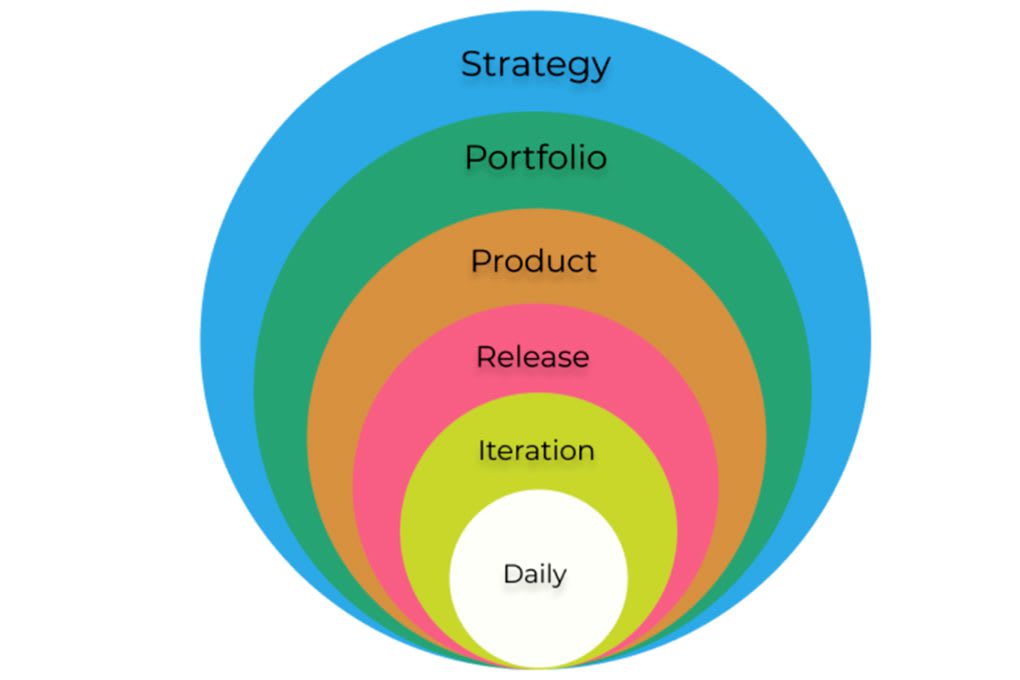
Let’s take a closer look at each layer of the onion, what it entails, and when it’s used.
- Strategy: This is a high-level approach to planning, often done at the beginning of a project when organizations define their long-term vision and identify resources and capabilities to reach strategic objectives
- Portfolio: In this stage, the focus is on managing a portfolio of projects or products, including prioritization, resource allocation, and alignment with business objective, ensuring that resources are applied effectively
- Product: In the product planning stages, teams define overall product strategy, decide on a development approach, and set dates, themes, timelines, and prioritize features to meet project goals and respond to market needs
- Release: Release planning breaks down the product roadmap into specific releases, focusing on which user stories to prioritize, each story’s timeline, team capacities, and the features or functionality to be delivered in each release
- Iteration: Iteration planning, also known as Sprint planning, defines the work to be done in a short iteration or sprint, usually spanning 1-4 weeks and involves breaking down user stories into tasks and estimating the effort required
- Daily: In the final layer, agile practices include the daily stand-up or scrum meeting to plan daily tasks and discuss progress and impediments, helping keep the team aligned and focused on the immediate tasks at hand
Agile planning process: Step-by-step
Agile project planning involves multiple steps. Each step is meant to propel your project forward while maintaining an organized approach to managing your product and workforce. The steps can be adapted to your team’s specific needs, and some need to be maintained on an ongoing basis, but overall, following the steps below will help you successfully implement an Agile plan for your next product launch.
1. Define vision
Your first step in Agile planning is to start by defining the vision for your project or product, which includes overall goals and objectives to be achieved. The product owner is often crucial in this early stage, ensuring that the vision aligns with user needs and business goals.
2. Set clear expectations on goals
Next, you should set clear expectations on what you want the output to be so that all team members and stakeholders are on the same page. Even if tasks or certain plans change due to feedback cycles and new iterations, the expectation should remain constant.
3. Define and break down the product roadmap
After setting expectations, it’s important to build a high-level product roadmap to highlight milestones and deliverables, giving your project more of a strategic direction. Then, the roadmap should be broken down into releases or increments, each with a defined set of features to include. Cross-functional teams often collaborate at this stage to ensure all perspectives are considered.
4. Create tasks based on user stories
This step should be more ongoing as project and user needs evolve over different iterations, but the idea is to create actionable tasks based on real user stories so that team members can work on adding new features, updating existing ones, or creating more functionality in your product.
5. Populate product backlog
Your product backlog is a collection of tasks and user stories that should be worked on over a project’s lifecycle. It includes tasks that aren’t a part of the current sprint but may be a part of future ones and can operate as a place to collect new tasks that arise as a result of feedback, roadblocks, or problems that need to be solved. Tasks in the product backlog should also be prioritized according to user needs or a project’s timeline.
6. Plan iterations and estimate effort
For each release, it’s important to plan a series of iterations or sprints. In this process, you want to define each iteration’s goals and objectives while also estimating the effort and time it may take based on the current sprint’s tasks. This helps gauge a sprint’s complexity so you can create an interaction plan based on current workfloads, deliverables, and timelines.
7. Conduct daily stand-ups
Daily meetings, often called stand-ups, are a helpful Agile ceremony that allows teams to discuss any pressing issues and plan the day’s work. Daily stand-ups are short and focused and involve very short-term planning to tackle a task currently being worked on.
8. Monitor and adapt
Finally, with Agile planning, it’s always important to monitor progress against overall goals, iteration plans, and your product roadmap. Track any deviations from the plan so you can find immediate solutions. At the end of each sprint, you can identify areas for improvement and implement them in future iterations.
These eight steps involve a lot of scheduling, planning, and communicating to implement effectively. To keep this process organized and running smoothly, many teams use a platform like monday dev, which is built on the monday.com Work Operating System (Work OS). Platforms like monday dev help teams run their projects, communicate between themselves, and track all updates in real-time.
Try monday devImplementing monday dev for effortless Agile planning
Agile planning’s structure and iterative approach to work make it the perfect complement to development teams, though any team can use this method. Once you have an understanding of how to use and maintain this methodology, take your Agile planning to the next level on monday dev. Not only will you always have a clear view of each sprint, but you’ll also be able to reinforce Agile principles such as transparency and agility every step of the way. Here’s a closer look at some monday dev features that are ideal for the Agile planning process.
Agile templates
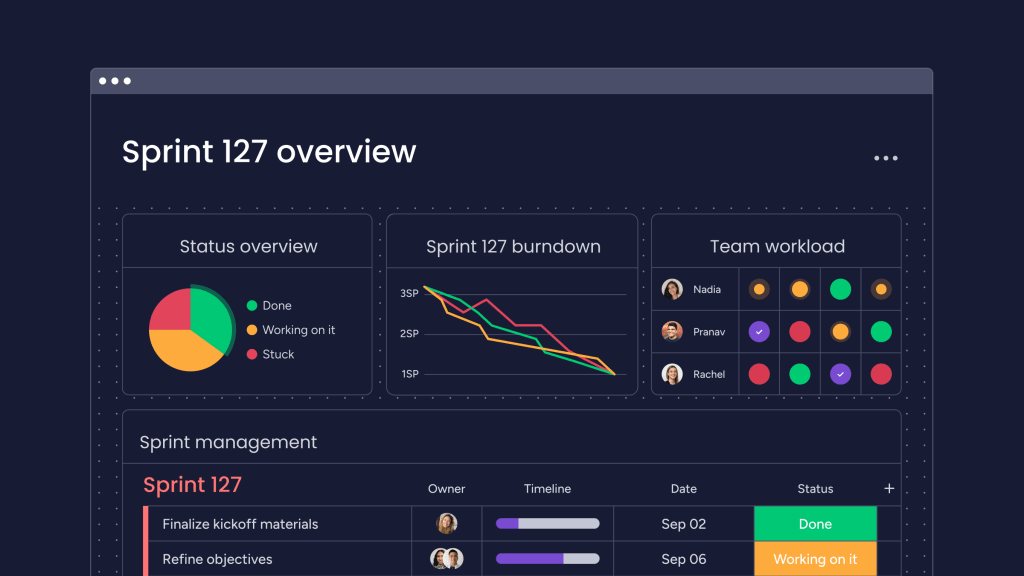
monday dev makes it easy to start quickly with ready-to-go templates for Agile planning. Whether it’s an Agile Project Management template or a Sprint Management template, you can set up your project instantly and customize the template to fit your needs within the agile framework.
Automations to seamlessly implement Agile planning steps
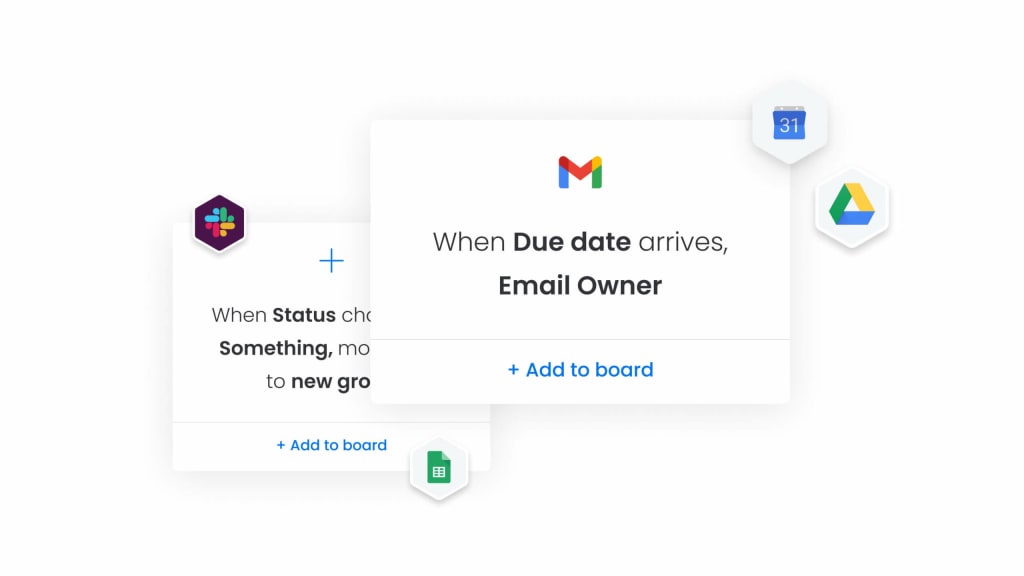
Automations in monday dev help Agile projects flow more seamlessly by putting manual tasks on autopilot. Build your own custom automation formulas to trigger reminders, notifications, communications, or other actions to ensure tasks are kept on time and nothing falls through the cracks.
Advanced reporting and insights for stronger iterations
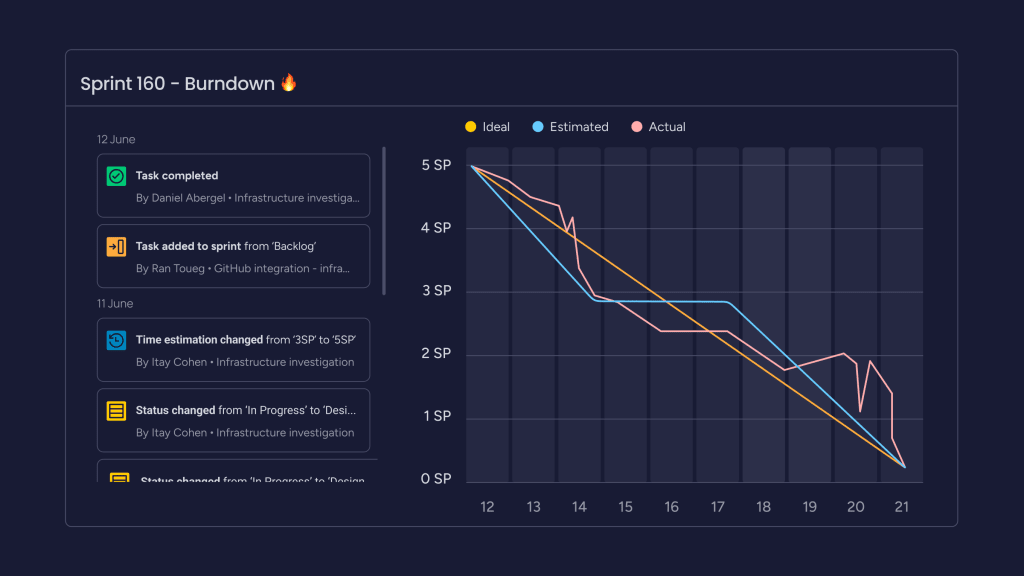
Agile planning is all about making adjustments to improve the flow of your project, and with monday dev’s advanced reporting capabilities, you can make sure you have all the insights you need to make informed decisions. From burndown charts to performance insights and everything in between, monday dev helps you stay consistently on top of your work.
Try monday devPlanning for better Agile projects
The more planning that goes into a project and all its tasks, the more likely the project is to go smoothly. Hiccups can always happen, but when a project is planned according to Agile practices, roadblocks are easier to manage. Agile planning is made even easier by using an intuitive platform like monday dev so that your entire team are aligned while staying on top of their individual tasks and working collaboratively towards the same goal.
FAQs
What is the Agile method of project planning?
The Agile method of project planning is a flexible, iterative approach involving different planning stages, focused on delivering value to customers through ongoing improvements and iterations.
What is the difference between strategic planning and Agile planning?
Strategic planning focuses on long-term goals and objectives, while Agile planning is more focused on short-term, iterative planning with the purpose of achieving an overall goal in a changing environment.
What is the difference between Agile and sprint planning?
Agile planning focuses on breaking down work into small, manageable tasks and prioritizing them based on effort and value, while sprint planning is a specific type of Agile planning that occurs at the start of each new sprint where teams decide on the work that will be done.
